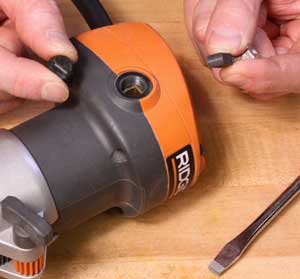
In all the years I’ve worked with power tools, I have not seen anything on changing brushes. Is there any period that, with average use, they should be checked? – Austin King.
Tim Inman: Brushes in electric motors my be the weak link that gets no respect. Since they do their work delivering electricity to the motor armature faithfully and with almost no trouble, they’re usually overlooked. In most motors, they seem to last forever because they get so little wear. In motors that are used often or under heavy loads, like routers, for example, they do wear down. As long as the motor is running properly and seems full of pep, there is probably no good reason to replace the brushes. However, inspection is important. The brushes are just pieces of carbon. If the brushes wear down to the end, the metal holders that carry them can cut into the motor armature and cause damage. Any motor that shows big blue sparks, or seems not to have the full power it should is likely past due for brush care. New brushes are commonly available as replacement parts. Otherwise, keep them blown out clean and keep using the tools.
Chris Marshall: Many handheld power tools these days have caps on the motor to make brush changing easier. But, as you say, not all manuals give clear instructions for when to do this or what to look for. (For tools that don’t have brush caps, changing the brushes yourself isn’t recommended and will probably void the tool’s warranty.) I pulled three different manuals from my files, and one says every 100 hours of use. Another recommends taking a look after 50 hours or 10,000 On/Off cycles. The third says every two to six months. Not a lot of help, really, because how many of us record the number of hours logged on a tool-especially if it’s only used occasionally? A more practical rule of thumb is to let the tool tell you when it’s time to pull the caps. If you can see more sparks than usual through the motor’s cooling vents, or if it occasionally cuts out during use, it’s likely that the brushes are worn or possibly deteriorated. Some brushes have wear indicator lines to show how much material is left, but not all do. If you don’t find any wear markings, replace brushes that are worn down to about 1/4 in. long or, of course, if they show signs of burning, cracks or crumbling.
Rob Johnstone: When it is time to change your brushes you will know. They start sparking and the machine drops RPM and it smells funny. (No kidding.)





